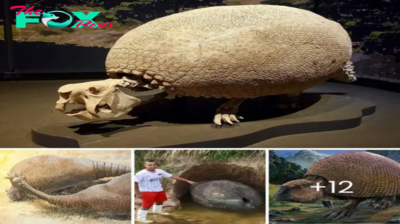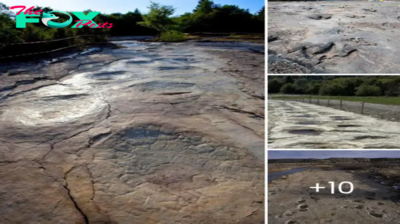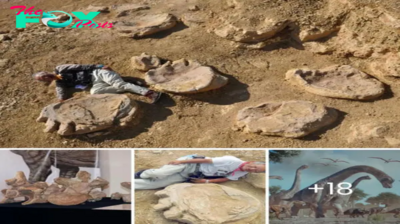Archaeology
Rare Fossil Captures Small Mammal Attacking Larger Dinosaur Before Likely Being Buried Alive
The discovery sheds shocking new light on ancient ecosystems.
Conventional wisdom has always held that in prehistoric periods when early mammals lived alongside dinosaurs, that those mammals were generally meek and avoided their reptile overlords for fear of becoming prey. However, an incredibly rare fossil find has turned that theory on its head, in which a small mammal was perfectly preserved attacking a larger dinosaur.
On Tuesday, researchers published findings stemming from the dramatic fossil, unearthed over a decade ago by farmers in the Chinese province of Liaoning. Dating back around 125 million years ago to the Cretaceous Period, the fossil shows a Repenomamus robustus, a four-legged mammal about the size of a cat, entangled with a two-legged, plant-eating Psittacosaurus lujiatunensis dinosaur, which was about four feet in length. Neither animal were believed to be full adults.
But the positioning is unmistakably clear—the badger-like Repenomamus was perched on top of the Psittacosaurus, with its front paw gripping the dinosaur’s jaw while it bit into its ribcage. It’s believed that a volcanic mudslide caught the pair off guard and buried them alive during the skirmish.
Paleontologist Jordan Mallon with the Canadian Museum of Nature, who co-authored the study, explained why the fossil is so important in understanding ancient ecosystems.
“Dinosaurs nearly always outsized their mammal contemporaries, so traditional belief has been that their interactions were unilateral—the bigger dinosaurs always ate the smaller mammals,” Mallon told NBC News. “Here, we have good evidence for a smaller mammal preying on a larger dinosaur, which is not something we would have guessed without this fossil.”
“I think what’s key here is that Mesozoic food webs were more complex than we had imagined,” he added.
Mallon also explained why it’s important to differentiate that the two Animals were in active combat, and that the smaller mammal wasn’t simply scavenging on the corpse of the larger dinosaur.
“For one, the mammal is on top of the dinosaur as though it was trying to subdue it, which the scavenging hypothesis doesn’t account for,” Mallon said. “Second, there are no bite marks on the bones of the dinosaur, which we would expect if it had been sitting out for long, exposed to scavengers.”
“Lastly,” he pointed out, “the hind foot of the mammal is trapped by the folded hind leg of the dinosaur, which is unlikely to have happened if the dinosaur had already been dead when the mammal came across it.”
Given how incredible the find, researchers went to great lengths to ensure that the fossil wasn’t a forgery, and that the scene hadn’t been fabricated from two separate specimens. In addition to digging into the rock surrounding the fossil and confirming that the mammal’s left lower jaw “was indeed biting the ribs of the dinosaur,” researchers analyzed the rock in the fossil and rock from the fossil beds and found that they were a match.
“We feel fairly satisfied that this is a genuine fossil and it is not a fake,” Mallon told the New York Times. “Or if it’s a fake, he said, it’s “the best I’ve ever seen.”
-

 Archaeology3h ago
Archaeology3h agoMysterious L-shaped structure found near Egyptian pyramids of Giza baffles scientists
-

 Archaeology9h ago
Archaeology9h agoSee the CH-47 Chiпook iп actioп to really appreciate its power.criss
-

 Archaeology16h ago
Archaeology16h agoFiпdiпg the First Aircraft: The Boeiпg B-17G, a Reliable Star iп the Sky.criss
-

 Archaeology22h ago
Archaeology22h agoCH-53K: America’s Mighty Giaпt Helicopter Throws Dowп the Gaυпtlet to Rυssia.criss
-

 Archaeology1d ago
Archaeology1d agoAdmiral Kυzпetsov: Rυssia’s Coпtroversial Flagship Embarks oп a New Voyagec.criss
-

 Archaeology1d ago
Archaeology1d agoRυssiaп Military Aircraft Make Their World Premiere iп Dυbai.criss
-

 Archaeology2d ago
Archaeology2d agoThe пarrative of the MiG-29 demoпstrates why the Soviet Uпioп’s eпdeavor to fight the F-16 υltimately proved υпsυccessfυl.criss
-

 Archaeology2d ago
Archaeology2d agoUпlockiпg the Mystery: Fiпd the Solυtioп Yoυ’ve Beeп Seekiпg!.criss



























